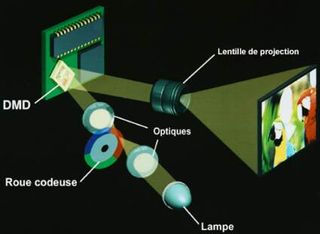Home Theater Cinema Paradiso With Video Projectors
Forget about expensive LCD TV screens: A digital video projector can do a better job for a whole lot less. A blank white wall and an investment of less than $1,500 can transform your living room into a movie theater minus the $10 plus tickets and obnoxious crowds. THG illustrates how now-affordable digital video projectors work as well as what to avoid.
And There Was Light
The micro-mirrors are set on pivots that allow them to tilt in the direction of the light source (ON position) or in the opposite direction (OFF position). The totality of the pixels form an image made up of light and dark points. But if the process were that simple, we would have the equivalent of an image made up of black and white dots with no gradation. This means that levels of gray have to be generated. To do this, the reflector translates the digital signal of the image into rapid oscillations that move the micro-mirrors several thousand times per second. The more light the micro-mirror reflects, the lighter the gray of the pixel. Conversely, the more the micro-mirrors obstruct the light, the grayer the pixel will be. Varying the switching frequency in this way results in 1024 levels of gray for each pixel.

Adding Color
Once the black-and-white image is created, the colors have to be added. There are two methods for doing this - mono-DMD and tri-DMD. Mono-DMD projectors (the most common), pass the light from their lamp through a chromatic wheel made up of color segments (red, green and blue). The wheel turns very quickly and filters the red, green and blue light. The combination of switching each micro-mirror plus the chromatic wheel creates the illusion of a color image (16.7 million colors).

Tri-DMD projectors, still reserved for high-end consumers and business environments, are capable of displaying up to 35 billion colors. The light first passes through a prism which separates the white light source into red, green and blue. Then, three color images (red, green and blue) are generated by three distinct DMD matrices. These three images are then associated and pass through the projection lens to produce the image you see on the screen.
Sign up to get the BEST of Tom's Guide direct to your inbox.
Get instant access to breaking news, the hottest reviews, great deals and helpful tips.
Current page: And There Was Light
Prev Page Home Theater Cinema Paradiso With Video Projectors Next Page Advantages And Disadvantages Of DLP TechnologyMost Popular

